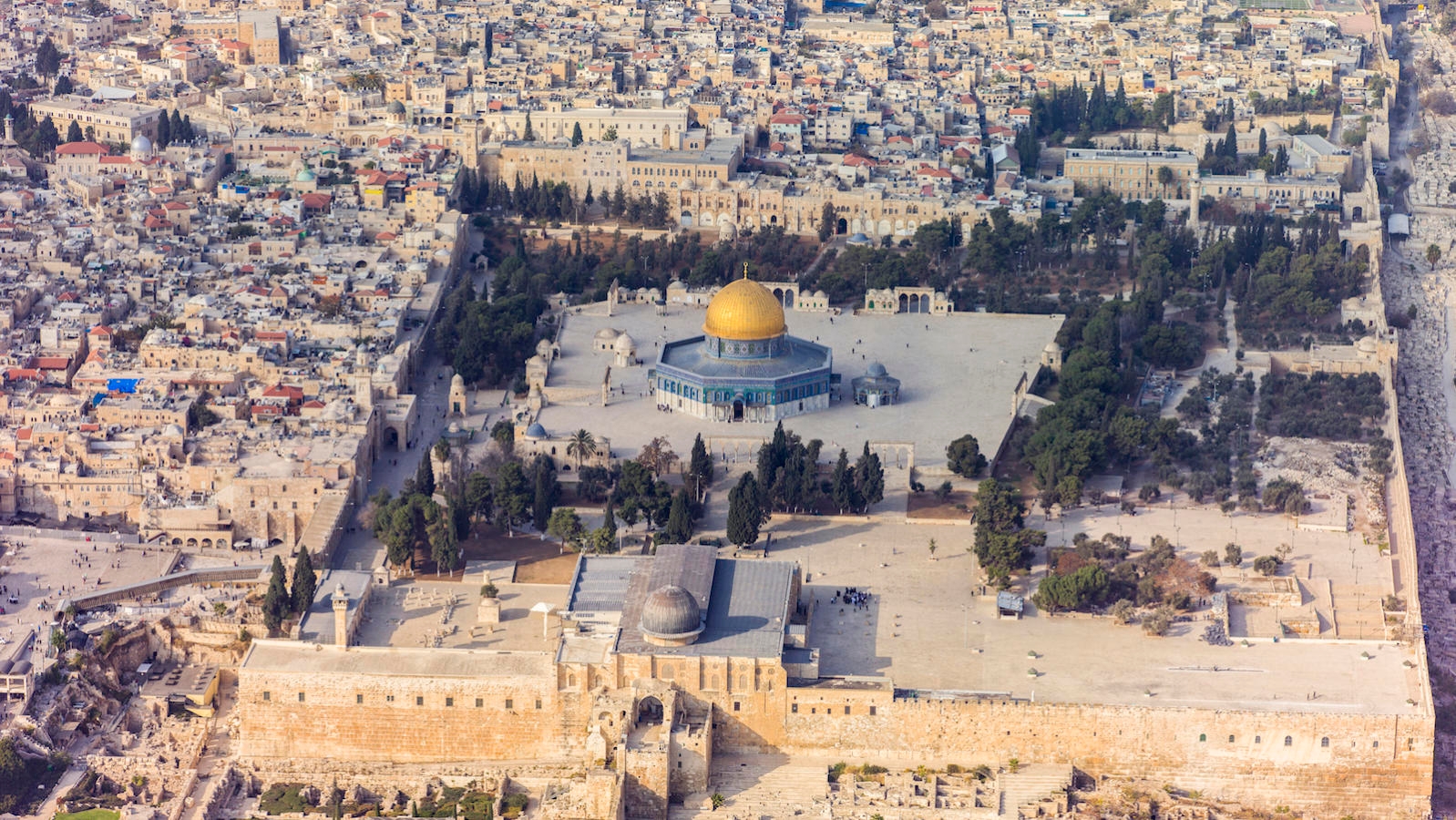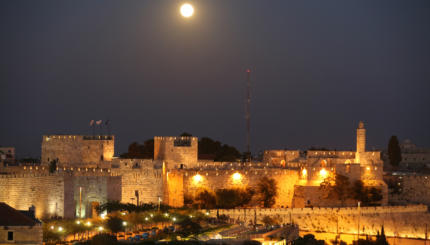The Temple Mount refers to the elevated plaza above the Western Wall in Jerusalem that was the site of both of Judaism’s ancient temples. The site is also the third holiest in Islam (after Mecca and Medina) and has been a focal point of inter-religious tension for decades. At present, the site is under Israeli sovereignty but is administered by the Muslim Waqf (religious trust). Jews and other non-Muslims are permitted to visit, but Jewish prayer is forbidden there — a provision long contested by a small number of Israeli Jews who oppose Muslim control over the site. Violence has flared at the site on numerous occasions, and Israeli forces sometimes restrict access to Muslims at times of elevated tensions.
Why is the Temple Mount holy to Jews?
The Temple Mount, known in Hebrew as Har Habayit, is traditionally said to be the site where Abraham demonstrated his devotion to God by taking his son Isaac to be sacrificed. The mount is also the site of both ancient Jewish temples. The first, built by King Solomon, was destroyed by the Babylonians in 586 BCE. The second was built in the sixth century BCE and stood for nearly 600 years before it was destroyed and the Jewish people exiled in 70 CE by the Roman Empire. Jews continue to mourn the destruction on the fast day of Tisha B’Av. According to Jewish tradition, a third temple will be built on the site during the messianic age.
Why is the Temple Mount holy to Muslims?
The Temple Mount is known to Muslims as the Haram al-Sharif (the Noble Sanctuary) and, according to Islamic tradition, is the site of Muhammad’s ascent to heaven in the seventh century. Today, the mount is home to the Al-Aqsa Mosque, the third holiest site in Islam, and the gold-topped Dome of the Rock, one of the most recognized symbols of Jerusalem.
Are Jews permitted to visit the mount?
Yes. However, traditional Jewish law has been understood to bar entry to the site. Jewish tradition regards entry to the Holy of Holies, the innermost sanctum of the temple where God’s presence dwells, as strictly forbidden, and as a result Jews traditionally did not enter the Temple Mount at all for fear of treading on sacred ground. (The exact location of the Holy of Holies is not known.) The Western Wall, the last standing retaining wall of the Temple Mount, is the closest to the mount that Jews are traditionally permitted to pray. However, Jews do visit the Temple Mount regularly.

Help us keep Jewish knowledge accessible to millions of people around the world.
Your donation to My Jewish Learning fuels endless journeys of Jewish discovery. With your help, My Jewish Learning can continue to provide nonstop opportunities for learning, connection and growth.
Who controls the Temple Mount?
Since Israeli forces regained control of the Old City of Jerusalem during the Six-Day War of 1967, Israel has extended its sovereignty over the site, though most of the world regards Israeli authority in all of eastern Jerusalem to be illegitimate. Day-to-day authority over the site rests with the Jerusalem Islamic Waqf. A waqf is a charitable trust recognized by Islamic law. Jordan, which had controlled eastern Jerusalem and the Islamic holy sites prior to 1967, continued to exercise a special guardianship over the mount, an arrangement later codified in the 1994 Israel-Jordan peace treaty, under which Israel “respects the present special role of the Hashemite Kingdom of Jordan in Muslim Holy shrines in Jerusalem.” Overall security for the site, including entry to visitors and worshippers, rests with Israeli security forces.
What is Israel’s policy on access to the mount?
The Temple Mount may be accessed by anyone, but entry to the Dome of the Rock is restricted to Muslims. Though there are multiple gates to access the site, non-Muslims must enter through the Mughrabi Gate, located near the Western Wall plaza. Israeli security controls the entry points. At moments of elevated tensions, Israel has occasionally closed the site to visitors, including Muslim worshippers.
Why is the site a flashpoint for violence?
The religious sensitivities surrounding the Temple Mount have repeatedly made the site a flashpoint for violence and unrest. Palestinians have long suspected that Israel intends to alter the status quo established for the site following the 1967 war, and some Palestinian leaders have even claimed that the Jewish temple never stood there. In 2015, rumors that Israel was preparing to impose a change at the site was said to be a contributing factor to the so-called “stabbing intifada,” during which a number of knife attacks were perpetrated against Israeli civilians in Jerusalem and elsewhere in the country. In September 2015, Palestinian Authority President Mahmoud Abbas said on Palestinian television that Israelis would not be permitted to “defile” the Al Aqsa Mosque with their “filthy feet.” Israel has emphatically denied that it wants to change current arrangements at the site; however several Israeli leaders have made symbolic shows of asserting Israeli sovereignty there and there have been plots by Jewish fringe groups to blow up the Dome of the Rock. In September 2000, then opposition leader Ariel Sharon undertook a visit to the site under heavy guard, sparking riots that would eventually blossom into the Second Intifada. Tensions are frequently elevated during Yom Yerushalayim (Jerusalem Day) on which Jews celebrate the 1967 recapture of the Western Wall and during the Muslim holiday of Ramadan.
Why are some Israeli Jews pushing for greater access to the site?
Efforts to secure Jewish prayer rights at the Temple Mount have gained traction in recent years, despite the mainstream rabbinic opinion that Jews should not set foot there. A number of rabbis have issued contrary rulings, saying that visitation and prayer should be permitted, and by some estimates the number of Jewish visitors has vastly increased. Among the most prominent activists is Yehuda Glick, an American-born rabbi and current member of the Israeli . Glick is a leading figure in efforts to secure Jewish prayer rights on the mount, framing his campaign in the language of civil rights. In 2014, he survived an assassination attempt by a suspected member of Islamic Jihad.
Ashkenazi
Pronounced: AHSH-ken-AH-zee, Origin: Hebrew, Jews of Central and Eastern European origin.

Help us keep Jewish knowledge accessible to millions of people around the world.
Your donation to My Jewish Learning fuels endless journeys of Jewish discovery. With your help, My Jewish Learning can continue to provide nonstop opportunities for learning, connection and growth.
Sephardic
Pronounced: seh-FAR-dik, Origin: Hebrew, describing Jews descending from the Jews of Spain.

Help us keep Jewish knowledge accessible to millions of people around the world.
Your donation to My Jewish Learning fuels endless journeys of Jewish discovery. With your help, My Jewish Learning can continue to provide nonstop opportunities for learning, connection and growth.



